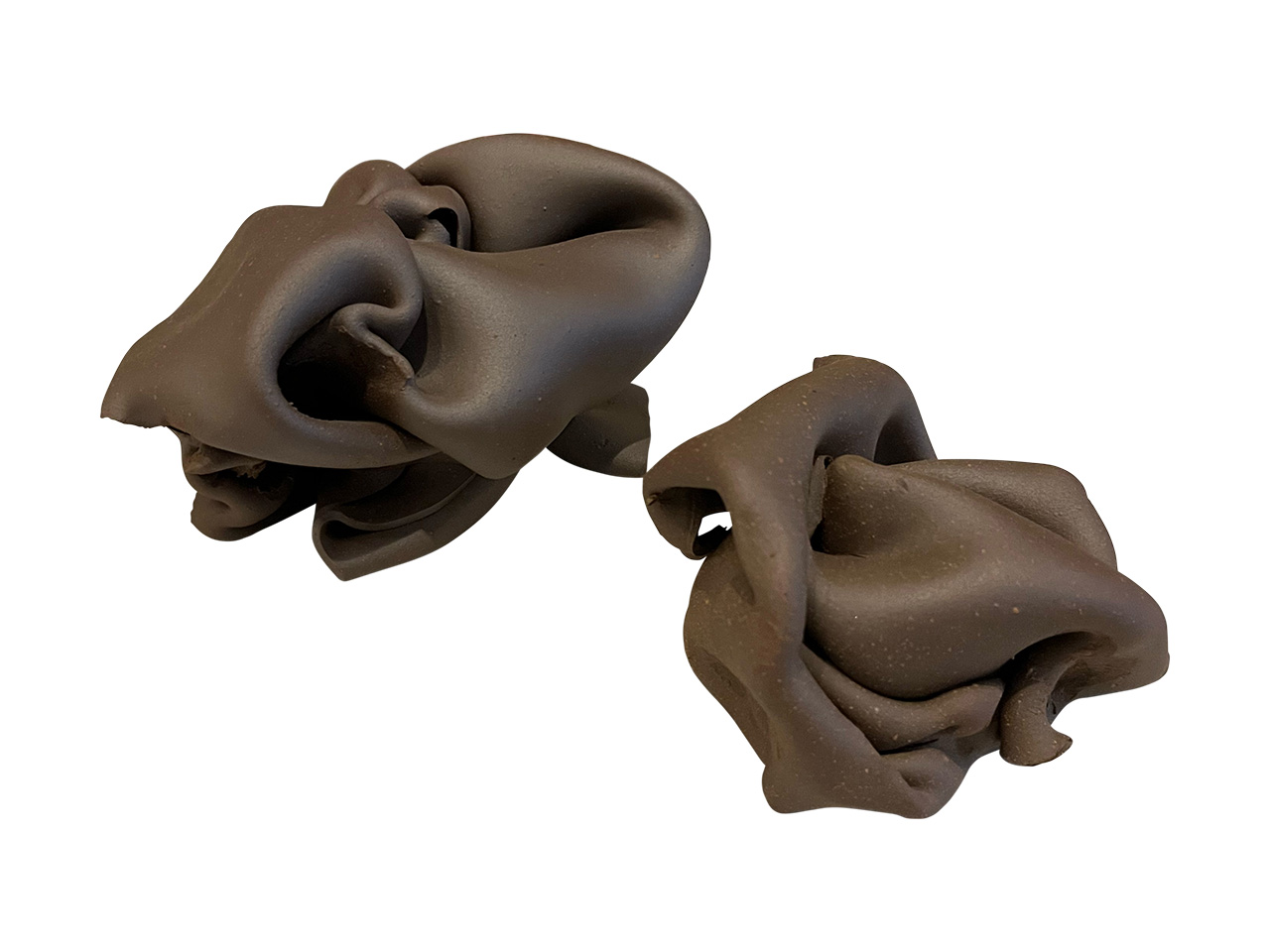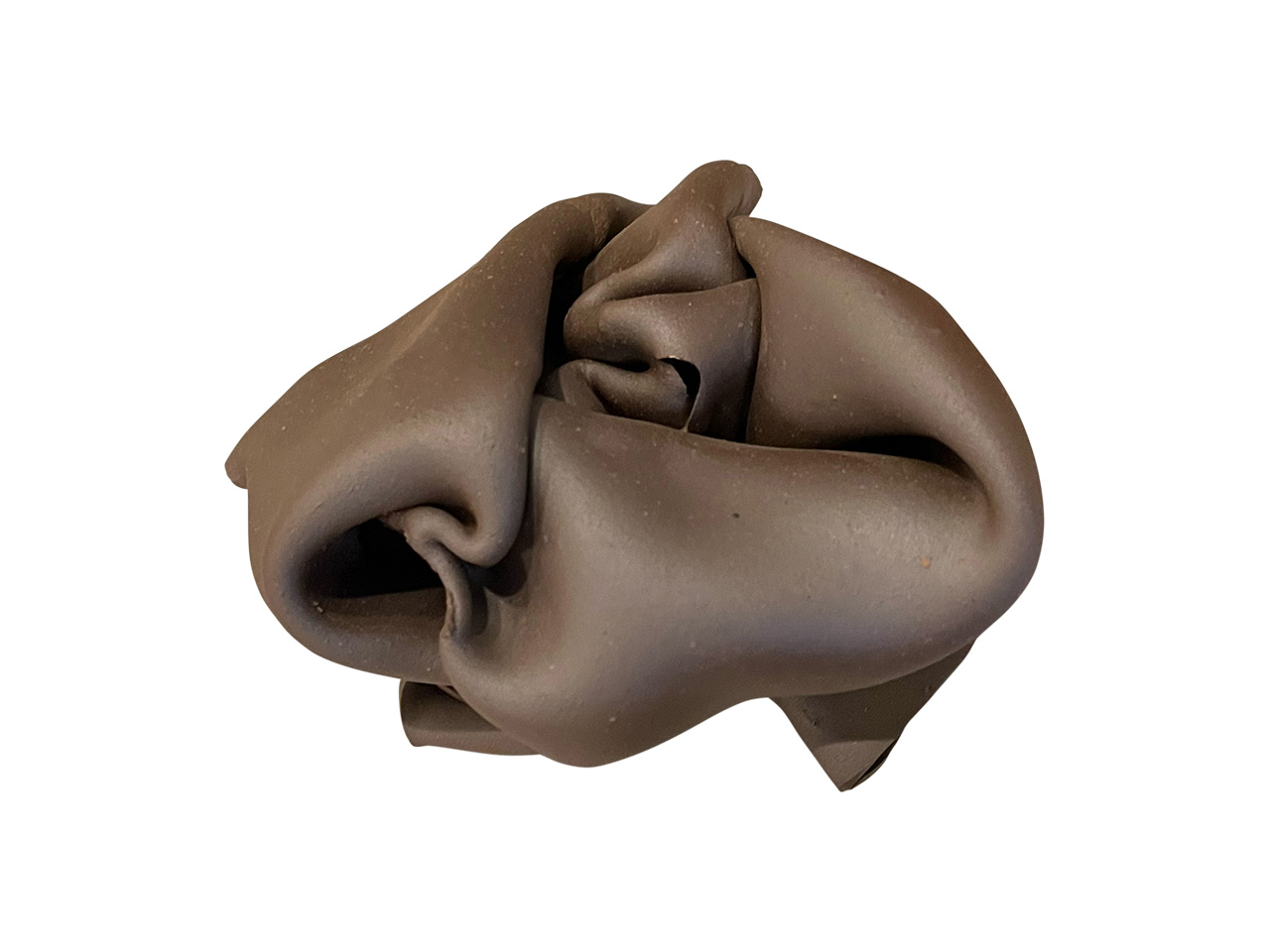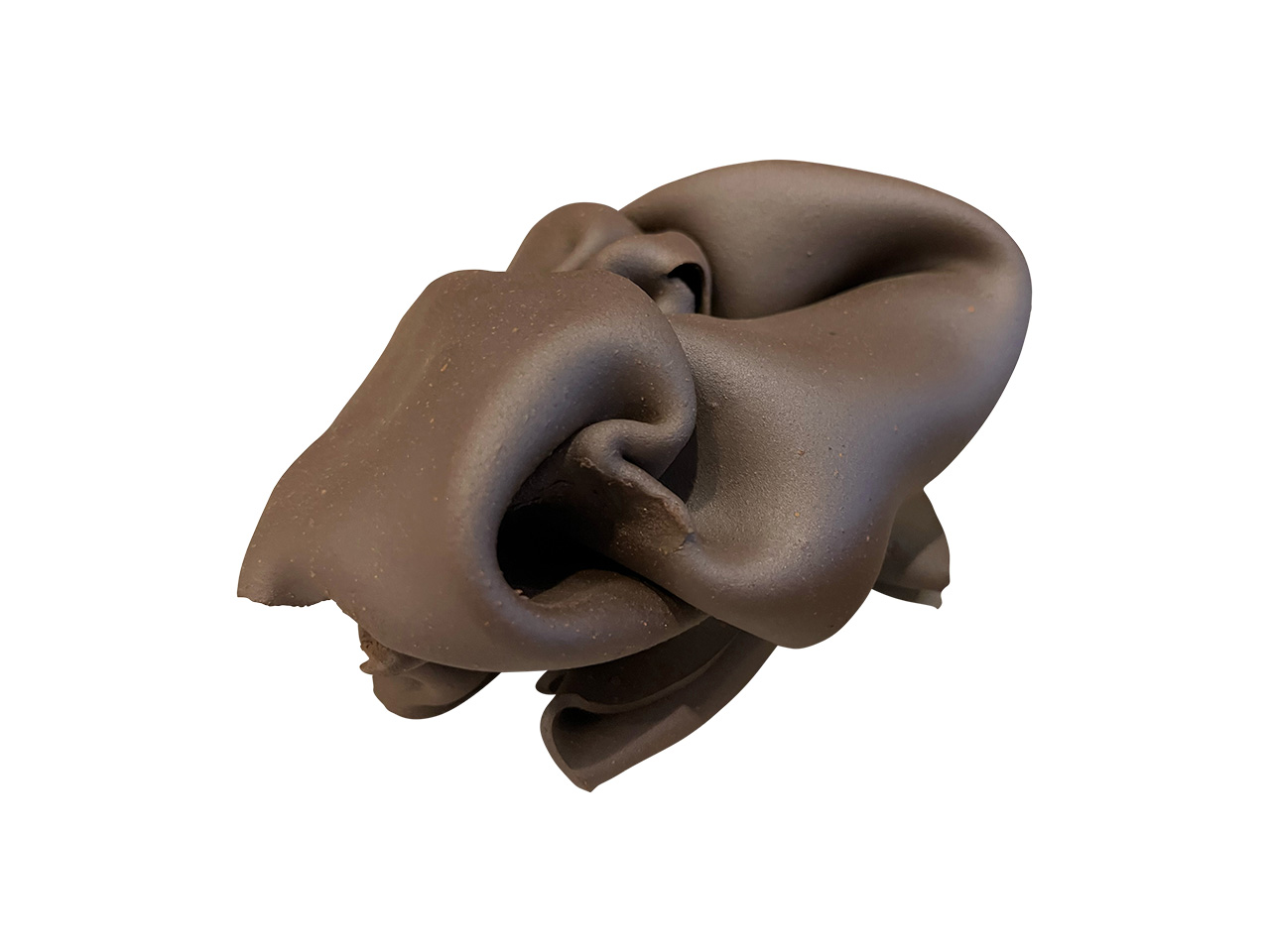伊藤 公象/Ito Kosho
美術家の伊藤公象(1932~)は、土の特性を活かした作風と、展示する空間と呼応するインスタレーションでよく知られており、インド・トリエンナーレ(1978年)やヴェネツィア・ビエンナーレ(1984年)に日本代表として参加するなど、国際舞台でも高く評価されている土の造形の先駆者です。
伊藤の父は、金沢の彫金家である伊藤勝典(しょうてん・1899~1943)ですが、勝典が後年大阪の造幣局に勤めていた関係で、伊藤も同地で生まれ育ちました。戦時中に父が亡くなると、父の知人であり九谷焼の名工の中村翠恒(すいこう・1903~1985)に十代半ばで弟子入りし、陶芸の基礎を学びます。絵付けよりも形態に関心を寄せた彼は、やがて花瓶や茶わんといった型通りの造形や機能による制約に反発を覚え、5年間の修業を経て伝統工芸の世界から離れることとなりました。
1954年からは富山新聞社で美術批評家を目指しますが、記者として地元の美術家たちと交流するなかで、創作への思いが再燃します。ここから、現代美術家としての伊藤の道が新たに切り拓かれていきました。1969年以降は茨城県笠間市に拠点を移し、1972年に造形作家の妻である伊藤知香とともに郊外の山裾に美術工房「桑土(そうど)舎」(現・伊藤アトリエ)を設立しました。2002年からは長男夫婦も加わり、同地を拠点としてそれぞれ独自の制作に取り組んでいます。
活動の初期における作品は主に木彫りでしたが、木という素材そのものが持つ生命力に魅力を感じていた伊藤は、人為的な制作方法に疑問を抱き、またしても創作活動に行き詰まりを見せます。このように、常識や伝統に対して常に懐疑的なまなざしを向け、独自性を志向するところに、伊藤という作家の資質を窺い知ることができます。
そんな彼がたどりついたのは、人の手による作為を極力抑え、素材そのものの特性や偶然性を重視する作品づくりでした。1974年の北関東美術展では、その最初の成果である「多軟面体(たなんめんたい)」で人々を驚嘆させます。陶土を3ミリ程度に薄くスライスし、即興的に手でまるめた不定形のフォルムをいくつも寄せ集め、そのまま焼成することで生み出された未知の生命体のような造形は、陶工芸のありかたを問い直す先鋭性に満ちていました。1980年代初頭には、湿った土の板に紙を密着させ、土が乾燥することで紙に生じた皺の型をとり、その型を再び土の表面にうつしとる「褶曲(しゅうきょく)」が生み出され、1982年には、凍結した土を掘り起こし、ほとんど手を加えないまま高温で焼成する「起土(きど)」なる作品が発表されました。1990年からは、紙のように薄く切断した磁土の板を様々なかたちに曲げて焼いた「木の肉・土の刃」シリーズが新たに加わり、その旺盛な実験精神と創作意欲は現在もとどまるところを知りません。様々な手法や形態に挑戦する一方で、土という自然物に秘められたエネルギーや造形美を追い求める姿勢と、土遊びを純粋に楽しむような童心は、「多軟面体」の頃から現在まで一貫してます。ゆえに、伊藤の作品はいずれも自然の息吹や脈動を感じさせ、その根源的な力によって鑑賞者のこり固まった感覚を解きほぐしていくのです。
Kosho Ito (1932-) is a renowned artist known for his unique style that utilizes the properties of clay and his installations that respond to the spaces in which they are displayed. He is a pioneering figure in clay modeling and has been highly acclaimed on the international stage, representing Japan at the India Triennale (1978) and the Venice Biennale (1984).
Ito’s father, Shoten Ito (1899-1943), was a metal engraver in Kanazawa. Due to Shoten’s later employment at the Osaka Mint, Ito was born and raised in Osaka. After his father’s death during World War II, Ito became an apprentice in his mid-teens to Suiko Nakamura (1903-1985), a master of Kutani ware, where he learned the basics of pottery. After his father’s death during World War II, Ito became an apprentice in his mid-teens to Suiko Nakamura (1903-1985), a friend of his father’s and a master of Kutani ware, where he learned the basics of pottery. His interest leaned more towards form rather than decoration, and he eventually developed a resistance to the conventional shapes and functional constraints of items such as vases and tea bowls. This led to his departure from traditional crafts following five years of apprenticeship.
From 1954, he aimed to become an art critic at the Toyama Newspaper, but his interactions with local artists reignited his passion for creation. This marked the beginning of his journey as a contemporary artist. In 1969, he moved to Kasama City, Ibaraki Prefecture, and in 1972, established the art studio “Sodo-sha” (now Ito Atelier) at the foot of a mountain in the suburbs with his wife, Chika Ito, a fellow artist specializing in three-dimensional works. Since 2002, his eldest son and his wife have also joined them, each pursuing their own creative work at the same site.
In the early stages of his career, he primarily worked with wood carving. Yet his fascination with the life force inherent in wood led him to question artificial production methods, leading to a creative impasse. His skeptical attitude towards common sense and tradition, coupled with his pursuit of originality, reveals the qualities that define Ito as an artist.
He eventually embraced a style that minimized human intervention, emphasizing the properties and spontaneity of the materials themselves. In the 1974 North Kanto Art Exhibition, he astonished audiences with “Multi-soft Polygons”, a piece created by thinly slicing clay to about 3 millimeters, improvisationally molding numerous irregular forms by hand, and firing them as is. This creation, resembling an unknown life form, was characterized by a cutting-edge reassessment of pottery art traditions. In the early 1980s, he developed ‘Fold’, a technique in which he pressed paper onto a wet clay slab, capturing the wrinkles that formed as the clay dried, and then transferring these patterns back onto the clay surface. In 1982, he unveiled “Kido”, works created by excavating frozen clay and firing it at high temperatures with minimal alteration. The “Meat of Wood, Blade of Clay” series, introduced in 1990, involved bending thinly sliced porcelain clay slab into various shapes before firing. His relentless experimental spirit and creative drive continue to this day. Despite experimenting with various methods and forms, his consistent pursuit of the inherent energy and aesthetic beauty of clay, along with a childlike joy in playing with the material, has remained unchanged since the days of “Multi-soft Polygons”. As a result, Ito’s works consistently evoke the breath and pulse of nature, employing their fundamental power to free the viewer’s stiffened senses.




作品名:無題
サイズ:大:H7×W15cm、小:H6×W12cm(セラミック)
価格:70,000円
価格は税抜き表示です

